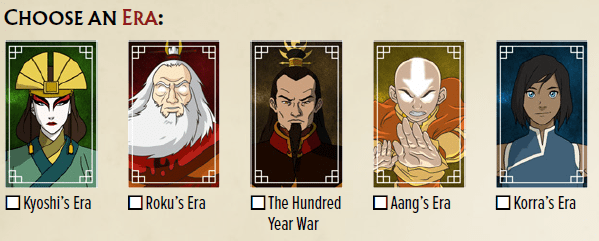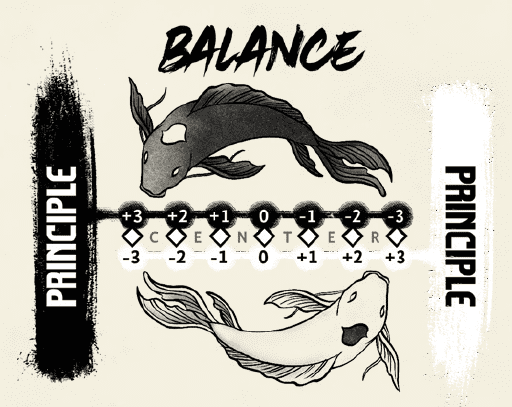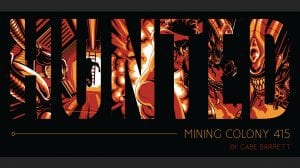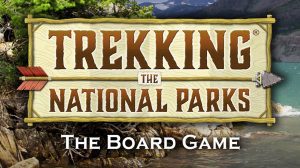If you’re reading this review, you’re probably already familiar with the excellent American anime show Avatar: the Last Airbender. For those of you who aren’t: stop reading this review right now and go watch the first few episodes. I promise you’ll be hooked — and once you are, you’ll understand why a tabletop roleplaying game (TTRPG) set in the Avatar world is a pretty big deal.
Though nominally a children’s show about preteens tasked with preventing an evil villain from conquering the world, Avatar: the Last Airbender proved to be far more than that. Its iconic visual styling, well-rounded characters, engaging plotlines, and deep worldbuilding managed to showcase the best elements of anime to American audiences in 30-minute, Nickelodeon-friendly chunks. From its initial launch, the world of A:tLA grew to include the sequel series Legend of Korra, an array of storylines in other media, and even a (dismally-received) live-action film. Together, all of these works — except the movie — have strengthened the setting and endeared it to many fans.
Central to the series’ concept is the idea of “bending”, an innate ability that allows some humans to create and manipulate one of the four elements (air, water, earth, or fire). While not all characters in the world have this ability, those who do tend to work together with others of their kind and practice specific forms of bending to overcome obstacles. Unique among the bending population is the Avatar, capable of bending all four elements; as a result, they serve as a defender of balance amongst the four nations. The Avatar is reincarnated whenever they die, meaning that there is always an Avatar somewhere — though it’s worth mentioning that each Avatar is still human and consequently is not always up to the challenges that they must face.
Avatar Legends: the Roleplaying Game adds a new way to experience this story and setting. Players will choose 1 of the 5 major historical periods, such as Roku’s Era or the Hundred Year War Era. One player will serve as the Game Master (GM) who shepherds characters created by the other players through a campaign of adventures of their own devising. While there is no indication that players will be able to take on the role of the Avatar, players have ample tools to create their own heroes and save the world.

The Ember Island Players
Character creation in Avatar Legends engages all the players at the table and emphasizes the cinematic nature of the setting. Each character uses a Playbook — similar to a class in traditional TTRPGs like Dungeons & Dragons — as the basis for their specific character. For example, you may play as a protective Guardian who looks out for their companions or an Idealist whose unshakeable beliefs inspire those around them. Note that these Playbooks are personalities, rather than skillsets. Your Guardian could as easily be an airbender as an earthbender. They may not be able to bend at all! There’s plenty of room for characters who use non-bending fighting styles or superior technology to solve problems. This is described as the character’s Training and Fighting Style: the elements or tools they rely on when the going gets tough.
The players will spend a fair amount of time developing their characters’ personalities before the game even fully starts. They’ll fill in the character’s Backgrounds — such as a Privileged or Wilderness upbringing — and choose one of the Demeanors associated with their Playbook which describe how the character acts in social situations. Are they haughty and restrained or humorously boorish? The choice is up to you.
Each character requires a History, wherein the player answers 5 questions that explore the character’s motivations, loved ones, beloved objects, and role in the group. This last question will be expanded by finding Connections between the characters: perhaps one member of the team feels particularly protective of their little brother or resents a groupmate’s innate skills.
The group as a whole will choose a few elements that frame their adventures: a Scope, a Focus, and an Inciting Incident. Scope broadly covers how large the characters’ world is: are they a ragtag group of rebels trying to stay out of trouble in their city or bold heroes who travel from nation to nation helping others? Focus is the group’s shared goal that will drive them through the course of the campaign: “defeat the evil Fire Lord” would be an example of the original series’ Focus. The Inciting Incident is a short story (roughly 3 sentences) that explains what brought the team together before the events of the campaign begin.
This might sound like a lot of work to get started, and for new players it might be a little off-putting at first. However, these aspects of character and team design are important to lay the foundation for what’s to come. Characters and their relationships to each other are central to the action in Avatar Legends. Putting in a bit of extra time to define the group and its members will pay off with a richer story for everyone once players get into the gameplay of a session.
Zhu Li, Do the Thing!
Avatar Legends builds off of the Powered by the Apocalypse (PbtA) rules system and as such shares a lot of its DNA with other titles like Apocalypse World and Masks. Games with this structure involve the players making Moves — in other words, taking actions — which are resolved by rolling 2d6 and adding or subtracting any relevant modifiers. On a 6 or less, the player misses and faces a major complication; on a 7 or higher they succeed at a cost, with a total success only occurring at 10 or higher. It’s a very popular system, and with good reason: PbtA games put the narrative at the forefront of play. Rather than have a series of uninteresting failures, every roll leads directly to something else that’s just as interesting as the thing that prompted the roll.
When a character attempts a Move, they will often add one of their stats (the mechanical numbers that show their character’s skill level) as a modifier to the roll. Characters in Avatar Legends have 4 main stats: Creativity, Focus, Harmony, and Passion. These work roughly the way their names would suggest; Harmony, for example, is a measure of social grace and the ability to empathize with others. Each of these stats starts between -1 and +2 for new characters.
There are a few other mechanical bits here as well. Fatigue is a 5-box track that measures the character’s physical exertion. Fatigue is spent by marking a box on the track in order to fuel many of the game’s offensive and defensive maneuvers. As characters run out of Fatigue, they may find themselves less effective; if they reach the 5th box on the track, they’ll begin taking Conditions instead.
Conditions are one of the most intriguing aspects of Avatar Legends. There is no real sense of “damage” or “health” in the game. Instead, the consequence of a Move often inflicts one of the 5 Conditions (Afraid, Angry, Foolish, Guilty, and Insecure) onto a character. For example, landing a successful strike in combat might make the recipient feel Angry or Foolish. Each Condition imposes a penalty to certain Moves; a character who is Afraid would struggle to intimidate others, while someone feeling Insecure is less likely to recall their training under pressure. If a character ever has all 5 Conditions marked and would take another, they fall unconscious. Conditions can be removed through play to help stave off a character’s collapse.
Each character also has a Balance track. This is a measure of the character’s commitment at any given moment to their central beliefs. The Balance track varies by Playbook and spans between two opposing concepts: say, Self-Reliance and Trust. Each step towards one end of the track is a step further away from the opposite end; a character who relies only on themselves will find it harder to trust others. Some Moves can shift a character’s balance — either their own or another character’s — to gain an advantage. Characters begin with their Balance at the center point between the two extremes, though over time their center point might shift permanently due to major events. If a character’s current Balance would ever go past one of the endpoints, they will temporarily lose control of themselves instead. What this means will depend on the situation, but it won’t be good.

That internal conflict can often spill over during combat. It’s no surprise that a game about magical martial artists and highly-skilled warriors might occasionally lead to a dust-up between player characters and their opposition. In this case, combat is resolved through a series of rounds with its own set of Moves that players can use (in addition to basic Moves and any specific to their Playbook).
During each round of combat — called an exchange — actions take place across three phases, called approaches: Defend and Respond, Advance and Attack, and Evade and Observe. There are specific Moves available during each approach; players wanting to land a strike, for example, must choose Advance and Attack in order to do so. All non-player characters (NPCs) will be secretly assigned an approach for the round, then the player characters (PCs) will plan out their tactics by choosing which approach each of them wants to use. Once all approaches have been decided, they are run in order with all characters making a Move of their choice during the approach they selected. This short-and-sweet initiative system keeps combat moving quickly and allows players to react more effectively to the ebbs and flows of an encounter in true Avatar style.
Tales of Ba Sing Se
Based on what I’ve seen in the Quickstart rules and the sample adventure, it’s clear that a lot of thought went into the design of Avatar Legends. Using the Powered by the Apocalypse system was a great choice overall. While it takes a little getting used to — the broadness of Moves is often a sticking point for new PbtA players — the emphasis is always on a cinematic style of play that fits perfectly with the source material. If you’re looking for a game that feels like an episode of Avatar: the Last Airbender or The Legend of Korra, this is it.
![]()
Of particular note is the interplay between Fatigue and Conditions. Fatigue powers both many basic Moves and some of the more exciting ones, so managing Fatigue is important. At the same time, Conditions are more immediately consequential since they apply specific penalties and determine how long a character can hold up under pressure. Balancing these two tracks adds a nice weight to the game without bogging players down with restrictions. Characters feel like they’re always on the brink of pushing themselves too far, yet it never feels particularly limiting.
Conditions are also where the emotional hook of the game really comes in: sure, you could play adding a Condition as a simple mathematical exchange, but Avatar Legends is at its best when the players all buy in to the concept and push for major emotional moments. A strike from the enemy might make your character feel Foolish or Insecure; finding out why is where the fun is. Does it show the enemy’s superior training, catch the character looking in the wrong direction, or remind them of a time when they were too slow to prevent something terrible? What does the enemy say to drive that pain home? Getting a handle on this system (and the similar Balance system) makes each beat of each scene so potentially resonant that it makes me giddy. Our big showdown in the sample adventure felt like a conflict that had been brewing for months instead of a few hours.
The flip side is that sometimes it can be really difficult to figure out why something affects a character so profoundly. Saying “the guard hits you with a spear and now you feel Guilty for…reasons” is a huge let-down that threatens to break the immersion completely. It’s a lot of heavy creative work for even the most minor encounter, and it might be especially difficult for a first-time GM who just wants to imagine some cool wuxia-style fights.
This is, after all, a game about bending the elements (or technology) to your will. The decision to separate that aspect from the Playbooks is an interesting one that I think works well. If you just want to play a firebender, you’re not tied to a specific build or personality type. Each Playbook offers a good mix of combat and non-combat options so none of them feel outclassed by any other. Moves are broad enough that anyone can participate effectively and describe exactly how their character does the cool thing.
On the other hand, it does mean that every character is effectively as good as the player’s imagination. In the Quickstart rules there aren’t any restrictions on what bending looks like or how technology can be used. Unless your players are very dedicated, it’s unlikely that any of their character’s abilities will truly resemble the ritualistic and focused bending found in Avatar: the Last Airbender; instead, most players will gravitate to the free-flowing MMA-style effects of Legend of Korra. This isn’t a bad thing, but I certainly hope that the full rules will include some guidance on how to incorporate the original show’s style into the game, particularly during the pre-Korra time periods.
That said, Avatar Legends is a great sandbox in which to play regardless of which era you pick or how you incorporate the bending. If the thought of exploring the Spirit World or fending off the Fire Nation sparks your interest, don’t wait a hundred years: back it on Kickstarter today!










Add Comment